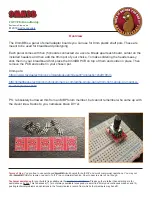
4
CS 2500
- Connecter la RJ45 " Control Out " sur la RJ45 " Control In " corres-
pondante du CS2003
- Connecter la RJ45 " Audio Out " sur la RJ45 " Audio In " corres-
pondante du CS2003
- Configurer les CS2003
- Poser les pupitres GX2500 sur leur plan d’utilisation
- Connecter l’alimentation des GX2500 issue bornier " OUT " de la
CS 2500
- Configurer les pupitres
- Connecter la RJ45 " Control / Audio " sur la RJ45 " Control / Audio
" correspondante de la GX2500
- Relier le bornier "ALARM UNIT" à la CMSI
- Raccorder les borniers " ALARM MODE OUTPUTS D " et " ALARM
MODE OUTPUTS I "
- Raccorder la RJ45 " Aux Remote Control "
- Relier la prise XLR " AUX " à une source de modulation (tuner, CD,
etc…)
- Relier la prise RS232 à un ordinateur ou un organe de supervision
- Configurer la
CS 2500
.
VI - PRINCIPE DE FONCTIONNEMENT
VI - OPERATING PRINCIPLE
6.1. INTERFACE HOMME-MACHINE
L’interface homme-machine est facilitée par l’utilisation de menus
déroulants à choix multiple. L’accès aux menus de configuration
de la
CS 2500
est protégé par un mot de passe à 4 digits pouvant
être modifié par l’utilisateur.
L’appareil est équipé de touches de navigation, de touches de
fonctions et d’un afficheur 4 lignes de 20 caractères.
Les touches de navigation sont :
- " " pour remonter
- " †" pour descendre.
- " C " pour annuler le choix en cours
- " OK " pour valider le choix pointé par le curseur " "
Les touches de fonction sont :
- touche " LAMP TEST "
- touche " RESET "
- touche " ACCEPT "
Après la modification d’un paramètre, il faut reinitialiser le
CS 2500
.
6.2. ARCHITECTURE GENERALE DES MENUS
A la mise sous tension, la page " MENU " s’affiche. La figure suivan-
te donne l’architecture des menus.
1. Mode manuel
1-1 Msg évacuation
1-2 Msg alerte
1-3 Msg information
1-4 Msg de test
2. Config CS 2500
(Mot de passe)
2-1 Mise à l’heure
2-2 Entrées sélect.
2-3 Paramétrage AMI
2-4 Paramétrage AMD
2-5 Mot de passe
3. Config système
(Mot de passe)
3-1 Nombre de GX 2500
3-2 Nombre de CS 2003
3-3 Niveau priorités
3-4 Batterie
3-5 Chargeur batterie
4. Prog groupes
(Mot de passe)
4-1 Créer
4-2 Editer
4-3 Supprimer
5. Routage matrice
6. Journal défauts
- Connect the RJ 45 “Control Out” to the corresponding RJ45
“Control In” of the CS 2003
- Connect the RJ 45 “Audio Out” to the corresponding RJ45
“Audio In” of the CS 2003
- Configure the CS 2003 units
- Place the GX 2500 consoles on their working surface
- Connect the power supply of the GX 2500 units to the “Out”
terminal of the
CS 2500
- Configure the consoles
- Connect the RJ 45 “Control / Audio” to the corresponding
RJ45 “Control / Audio” of the GX 2500
- Link the “ALARM UNIT” terminal to the FDS
- Plug in the “Alarm Mode Outputs D” and “Alarm Mode Outputs
I” terminals
- Plug in the RJ 45 “Aux Remote Control”
- Link the XLR “Aux” socket to a signal source (tuner, CD, etc.)
- Plug RS232 link to a computer or a supervising device.
- Configure the
CS 2500
.
1. Manual mode
1-1 Evacuation msg
1-2 Alerte msg
1-3 Information msg
1-4 Test msg
2. Config CS 2500
(Password)
2-1 Time setting
2-2 Input selection
2-3 Setting AMI parameters
2-4 Setting AMD parameters
2-5 Password
3. Config system
(Password)
3-1 Number of GX 2500s
3-2 Number of CS 2003s
3-3 Level of priority
3-4 Battery
3-5 Battery charger
4. Prog groups
(Password)
4-1 Create
4-2 Edit
4-3 Delete
5. Matrix routing
6. Fault log
6.1. MAN-MACHINE INTERFACE
The man-machine interface is provided by the use of multiple-
choice, pull-down menus. Access to the
CS 2500
configura-
tion menus is protected by a 4-digit password, which can be
changed by the user.
The unit is equipped with navigation keys, function keys and a
display with 4 lines of 20 characters.
The navigation keys are:
- "π" to go up
- "†" to go down
- "C " to cancel the present choice
- "OK" to accept the choice indicated by the cursor " "
The function keys are:
- "LAMP TEST" key
- "RESET"key
- "ACCEPT" key
Reinitialise the
CS 2500
, after a modification of parameter.
6.2. GENERAL MENU ARCHITECTURE
When power is switched on the “MENU” page is displayed.
The following diagram shows the menu architecture.


























